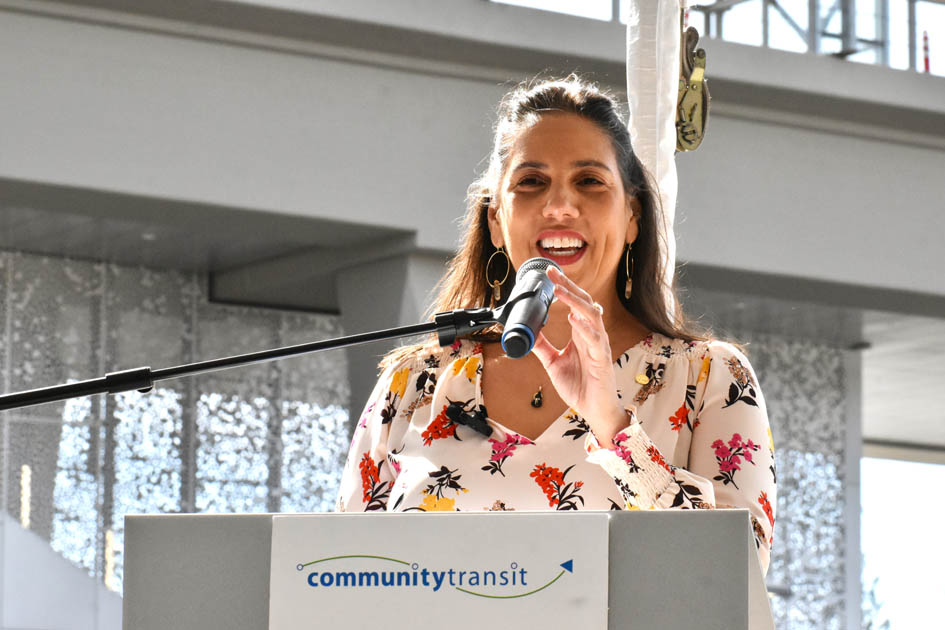WASHINGTON, D.C.—Transit agencies throughout Washington state will now have access to $388 million in formula-based grant funding to improve public transportation in their communities. The announcement came Thursday, April 4, from Federal Transit Administration (FTA) Acting Administrator Veronica Vanterpool. The Seattle-Tacoma region alone will receive $267 million in the reimbursement grant program for which its Metropolitan Planning Organization (MPO) overseeing the urbanized zone—Puget Sound Regional Council—will determine the allocation of funds.

“The FTA’s much-needed support for the Puget Sound region will help us give commuters more options, prepare for climate change, and strengthen our economy,” said Snohomish County Executive Dave Somers. “As we build out light rail across the region, we need to ensure all of our transit systems are interconnected and environmentally sustainable. We appreciate this show of strong support from the FTA and our Congressional delegation.”
Other urbanized areas within Washington state receiving funding are:
- Bremerton, $6,736,852
- Kennewick-Richland-Pasco, $10,472,682
- Olympia-Lacey, $6,714,038
- Spokane, $14,543,641
A total of $20.5 billion in federal formula-based funding for transit agencies across the country was announced and was made possible by the $432.9 billion FY24 Funding Package passed on March 6 in the United States House of Representatives with a vote of 339 to 85 and on March 8 by the Senate with a vote of 75 to 22. The bill was signed into law by President Joe Biden on March 9, 2024.
“Our strong federal partnership is critical to providing the public transit service our region’s residents depend on, and to boosting our economy and environmental sustainability,” said Community transit CEO Ric Ilgenfritz. “We thank the Biden-Harris administration for these critical investments in our future, which will support Community Transit’s service expansions and transition to zero emissions buses.”

According to the FTA, this is the latest round of funding made possible by the Bipartisan Infrastructure Law (BIL), signed by President Biden in 2021, which provided $1.2 trillion for transportation and infrastructure. Of that total, $550 billion was allocated for new federal investments in America’s infrastructure.
The communities receiving the most funding, based on population and service data, include:
- New York-Jersey City-Newark, NY-NJ: $2.8 billion
- Chicago, IL-IN: $765.1 million
- Washington-Arlington, DC-VA-MD: $665 million
- Los Angeles-Long Beach-Anaheim, CA: $603.4 million
- Boston, MA-NH: $454.9 million
- Philadelphia, PA-NJ-DE-MD: $448 million
- San Francisco-Oakland, CA: $432.4 million
- Miami-Ft Lauderdale, FL: $272.4 million
- Seattle-Tacoma, WA: $267 million
- Baltimore, MD: $202.8 million
By allowing transit providers to move forward with applications for Fiscal Year (FY) 2024 federal support, the funding will help communities:
- expand, modernize, maintain, and operate public transportation systems;
- upgrade stations, tracks, and maintenance facilities;
- plan and design new transit corridors; and
- provide access for seniors and riders with disabilities.
“We are pleased to provide billions of dollars in federal support to communities thanks to the Bipartisan Infrastructure Law,” said FTA Acting Administrator Veronica Vanterpool. “Transit funds reach communities large and small, which depend on this funding to start new projects, fix old infrastructure, and ensure fast, safe, convenient service.”

Acting Administrator Vanterpool shared that the transit agencies can use the monies to buy new buses and rail cars, address repair backlogs, modernize fleets, and transition to new technologies to address the climate crisis – e.g. Zero emission buses. Reimbursements for station improvements, new tracks and transit facilities, and the planning and designing of new transit corridors are also eligible in this formula-based grant program.
“As part of President Biden’s infrastructure plan, we’re making history’s biggest-ever federal investment in transit – trains, buses, ferries, and more – so people can reliably and affordably get to wherever they need to be,” said U.S. Transportation Secretary Pete Buttigieg. “This $20.5 billion investment in public transportation will support the daily lives of millions of Americans across the country and help communities expand access to economic opportunity.”

“King County would like to thank the Biden administration and Congress for passing the full year 2024 funding,” said Jeff Switzer, King County Metro spokesman. “These funds will go towards helping King County move towards its climate goals of reducing carbon emission by helping Metro transition its bus fleet to zero emission, maintain facilities and equipment in a state of good repair, and improve mobility in South King County.”
The full-year FY 2024 funding is detailed in apportionment tables that specify funding to states, urbanized areas, and tribal governments based on statutory formulas and funding levels set by Congress. The apportionment tables allow transit agencies and grant recipients to view the amounts for programs by state and urbanized area so they can better plan and manage new and expanded transit projects that benefit their communities. Each year, more than 65 percent of the funding provided by FTA comes from the formula programs announced April 4.
This year, based on population changes from the 2020 Census, some areas will see changes to funding amounts due to factors such as new urbanized area boundaries. Other thresholds within the urban programs determine whether funds are apportioned to the states or directly to urbanized areas. In addition, the formulas use transit agencies’ ridership data from 2022, which reflects post-pandemic changes in travel patterns.
Formula-based grant programs include funding for transit systems in both urbanized and rural areas, grants for buses and bus facilities, transit designed for seniors and people with disabilities, planning funds, and support to improve the condition of transit assets.
Earlier this year, FTA released $9.9 billion in partial-year apportionments reflecting formula funding available for five months (October 1, 2023, to March 1, 2024) at FY 2023 levels while the federal government operated under a Continuing Resolution. The partial-year funding, which provided transit agencies an opportunity to draw down formula funding for time-sensitive needs, is a subset of the full-year amounts announced Thursday.
Author: Mario Lotmore









